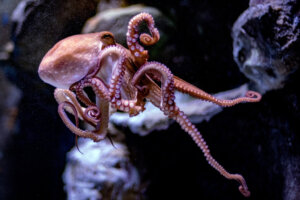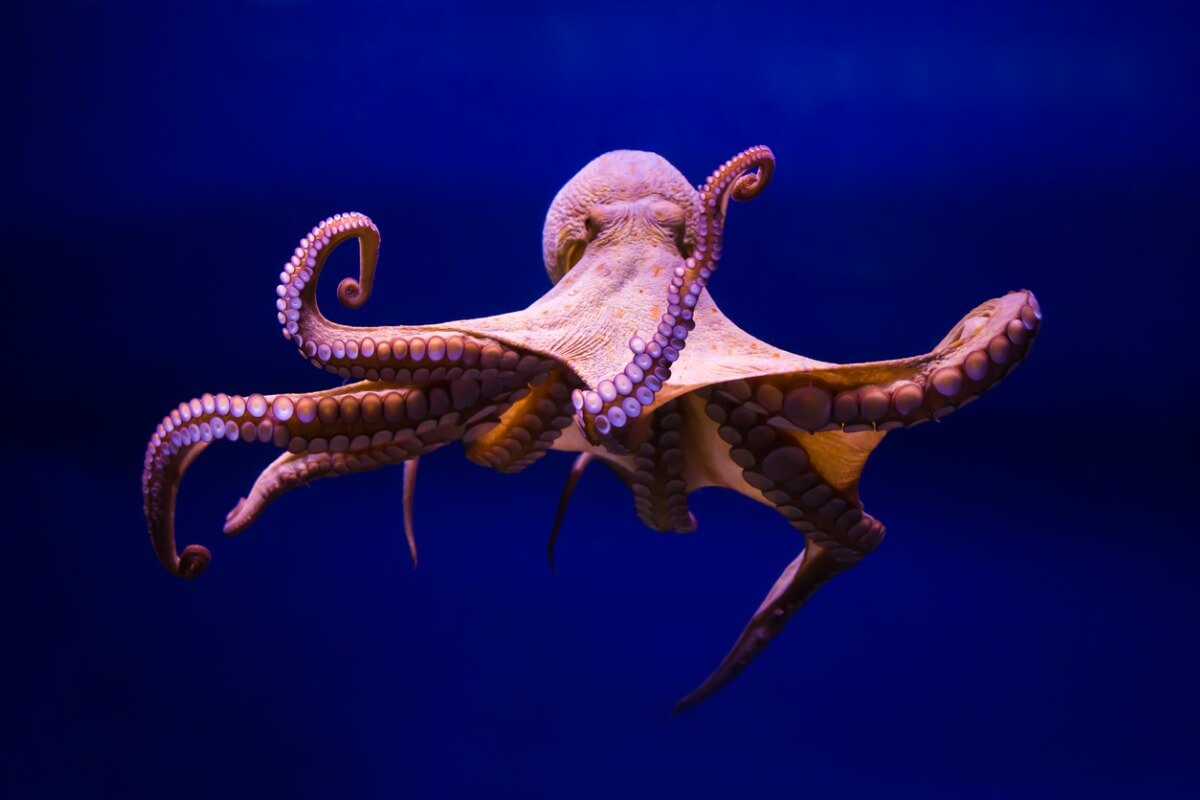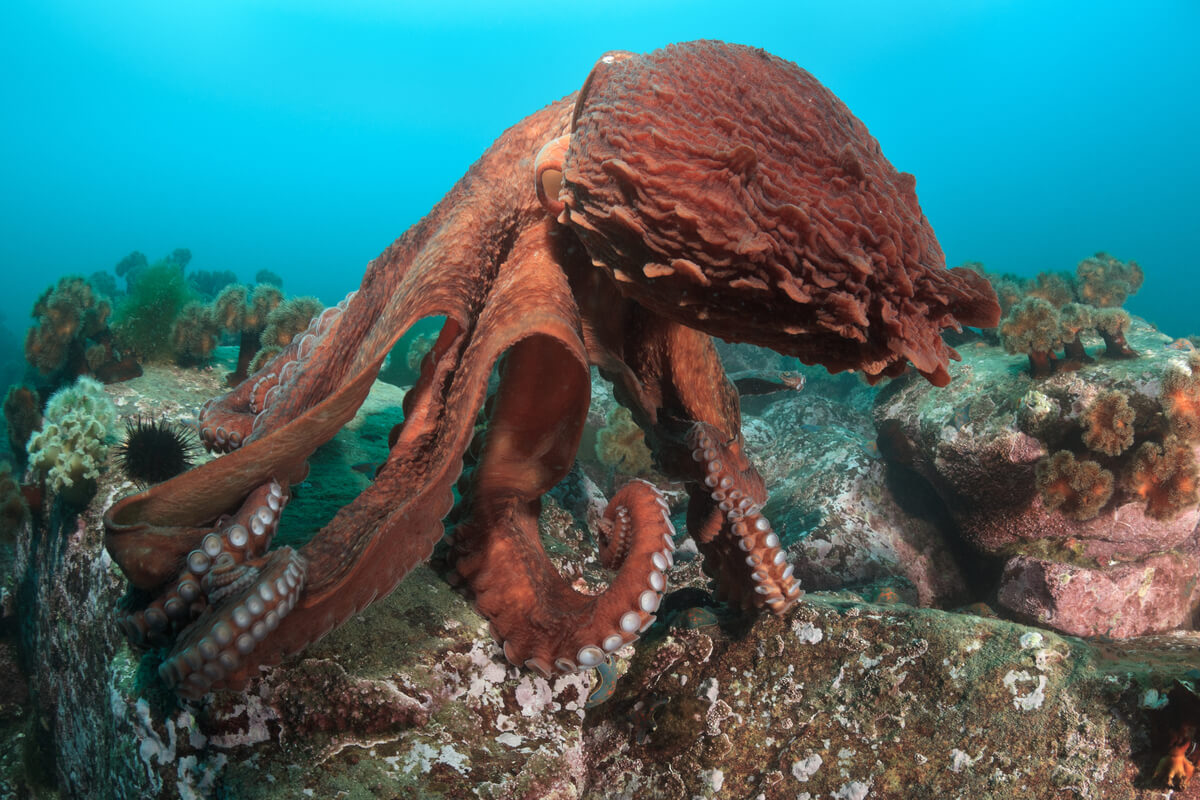How Do Octopuses Change Shape and Color?


Written and verified by the biologist Cesar Paul Gonzalez Gonzalez
Cephalopods are a group of animals that are characterized by having “feet on their heads”, which gives them the iconic appearance of this taxon. These species possess a great diversity of aspects and abilities. An example of this are the pigment cells that help octopuses change shape and color; this is common to other cephalopods too.
Octopuses are true deception artists, as their incredible abilities allow them to hide very effectively. This camouflage ability is called crypsis and consists of imitating the characteristics of their environment in order to hide. Read on and discover how octopuses change shape and color.
What are octopuses?
Octopuses, or octopods, are known for having eight tentacle-like limbs. They have a fairly soft body, and most of the time they move very close to the ground. They also have a special structure that expels water under pressure – this is known as a siphon. This is what allows them to escape at high speed by propelling themselves with a jet of water.
Octopuses are known to be one of the most intelligent invertebrates in existence. They learn quite quickly and are capable of solving simple cognitive problems. In fact, their brain seems to function in a similar way to that of humans, as both contain different types of neurons. Thanks to this, their nervous system has the ability to solve even more complex tasks.
The cognitive ability that octopuses have not only impacts their ability to solve problems, but also modifies their defense abilities. These animals have the ability to change the shape and coloration of their body, so they “mimic” their environment in order to escape. However, in order to do so, they need to survey their entire environment and understand its structure and color.
The processing of the information they receive through their senses needs to be fast, because, in an attack by a predator, they have little time to react. For this reason, the simple fact of “mimicking” the environment requires a great cognitive capacity.

How do octopuses change shape and color?
Formally, the ability used by octopuses to change their shape and color is known as crypsis. It’s very similar to mimicry, with the difference being that the animal that performs it tries to resemble its environment and not a living being. Because of this, these animals are difficult to find with the naked eye, as they spend much of their time hiding from predators.
The physical structure of octopuses doesn’t provide them with any specific means to defend themselves from predators. Their body lacks claws and is mostly made up of muscles, which makes it impossible for them to directly confront any enemy. For this reason, they have chosen to develop complex mechanisms that allow them to remain hidden.
How do they change color?
The mechanism that makes octopuses change color consists of a set of pigments (chromatophores) and several reflector cells (iridophores). On the one hand, the chromatophores function as a bag containing a large amount of basic pigments (yellow, red and brown), which don’t combine with each other.
The chromatophores are surrounded by many muscles and nerves that control their shape. When they expand, the pigments have room to emit their coloration, so that together they produce the color change in the octopus’ skin. In fact, this effect is very similar to what happens with pixels in a photo, where each pigment contributes its color to produce the final hue.
The only problem is that for octopuses to produce any color at all, blue is needed. This pigment isn’t part of the chromatophores, but it’s solved by the presence of other cells known as iridophores. These cells function as a kind of mirror; depending on their position, they’re able to reflect light and produce a particular hue. Thanks to this, the octopus completes the function of camouflage without any problem.

How do they change the shape of their body?
As mentioned, most of the octopuses’ body is composed of muscles. This is what causes their appearance to be rather weak and even slippery. However, this characteristic plays an important role in its camouflage, because, with the right mechanisms, it’s able to contract its body and form textures.
In other words, to change the appearance of its body, it needs to contract its muscles with great precision and keep them that way for a while. Such a process allows its body to curve, remain static, or modify the appearance of its skin, just to resemble its surroundings. In this way, octopuses can adopt almost any shape in the marine environment.
Octopuses are magnificent animals that possess incredible defense mechanisms. They have managed to take advantage of their less useful characteristics and have produced a complex camouflage system that’s almost infallible. As if that weren’t enough, they have a great cognitive capacity, which together transforms this cephalopod into a true master of deception.
Cephalopods are a group of animals that are characterized by having “feet on their heads”, which gives them the iconic appearance of this taxon. These species possess a great diversity of aspects and abilities. An example of this are the pigment cells that help octopuses change shape and color; this is common to other cephalopods too.
Octopuses are true deception artists, as their incredible abilities allow them to hide very effectively. This camouflage ability is called crypsis and consists of imitating the characteristics of their environment in order to hide. Read on and discover how octopuses change shape and color.
What are octopuses?
Octopuses, or octopods, are known for having eight tentacle-like limbs. They have a fairly soft body, and most of the time they move very close to the ground. They also have a special structure that expels water under pressure – this is known as a siphon. This is what allows them to escape at high speed by propelling themselves with a jet of water.
Octopuses are known to be one of the most intelligent invertebrates in existence. They learn quite quickly and are capable of solving simple cognitive problems. In fact, their brain seems to function in a similar way to that of humans, as both contain different types of neurons. Thanks to this, their nervous system has the ability to solve even more complex tasks.
The cognitive ability that octopuses have not only impacts their ability to solve problems, but also modifies their defense abilities. These animals have the ability to change the shape and coloration of their body, so they “mimic” their environment in order to escape. However, in order to do so, they need to survey their entire environment and understand its structure and color.
The processing of the information they receive through their senses needs to be fast, because, in an attack by a predator, they have little time to react. For this reason, the simple fact of “mimicking” the environment requires a great cognitive capacity.

How do octopuses change shape and color?
Formally, the ability used by octopuses to change their shape and color is known as crypsis. It’s very similar to mimicry, with the difference being that the animal that performs it tries to resemble its environment and not a living being. Because of this, these animals are difficult to find with the naked eye, as they spend much of their time hiding from predators.
The physical structure of octopuses doesn’t provide them with any specific means to defend themselves from predators. Their body lacks claws and is mostly made up of muscles, which makes it impossible for them to directly confront any enemy. For this reason, they have chosen to develop complex mechanisms that allow them to remain hidden.
How do they change color?
The mechanism that makes octopuses change color consists of a set of pigments (chromatophores) and several reflector cells (iridophores). On the one hand, the chromatophores function as a bag containing a large amount of basic pigments (yellow, red and brown), which don’t combine with each other.
The chromatophores are surrounded by many muscles and nerves that control their shape. When they expand, the pigments have room to emit their coloration, so that together they produce the color change in the octopus’ skin. In fact, this effect is very similar to what happens with pixels in a photo, where each pigment contributes its color to produce the final hue.
The only problem is that for octopuses to produce any color at all, blue is needed. This pigment isn’t part of the chromatophores, but it’s solved by the presence of other cells known as iridophores. These cells function as a kind of mirror; depending on their position, they’re able to reflect light and produce a particular hue. Thanks to this, the octopus completes the function of camouflage without any problem.

How do they change the shape of their body?
As mentioned, most of the octopuses’ body is composed of muscles. This is what causes their appearance to be rather weak and even slippery. However, this characteristic plays an important role in its camouflage, because, with the right mechanisms, it’s able to contract its body and form textures.
In other words, to change the appearance of its body, it needs to contract its muscles with great precision and keep them that way for a while. Such a process allows its body to curve, remain static, or modify the appearance of its skin, just to resemble its surroundings. In this way, octopuses can adopt almost any shape in the marine environment.
Octopuses are magnificent animals that possess incredible defense mechanisms. They have managed to take advantage of their less useful characteristics and have produced a complex camouflage system that’s almost infallible. As if that weren’t enough, they have a great cognitive capacity, which together transforms this cephalopod into a true master of deception.
All cited sources were thoroughly reviewed by our team to ensure their quality, reliability, currency, and validity. The bibliography of this article was considered reliable and of academic or scientific accuracy.
- Cloney, R. A., & Brocco, S. L. (1983). Chromatophore organs, reflector cells, iridocytes and leucophores in cephalopods. American Zoologist, 23(3), 581-592.
- Mäthger, L. M., & Hanlon, R. T. (2007). Malleable skin coloration in cephalopods: selective reflectance, transmission and absorbance of light by chromatophores and iridophores. Cell and tissue research, 329(1), 179-186.
- Williams, T. L., Senft, S. L., Yeo, J., Martín-Martínez, F. J., Kuzirian, A. M., Martin, C. A., … & Deravi, L. F. (2019). Dynamic pigmentary and structural coloration within cephalopod chromatophore organs. Nature communications, 10(1), 1-15.
- Styfhals, R., Zolotarov, G., Hulselmans, G., Spanier, K. I., Poovathingal, S., Elagoz, A. M., … & Seuntjens, E. (2022). Cell type diversity in a developing octopus brain. bioRxiv.
- Gilmore, R., Crook, R. & Krans, J. L. (2016) Cephalopod Camouflage: Cells and Organs of the Skin. Nature Education 9(2):1
This text is provided for informational purposes only and does not replace consultation with a professional. If in doubt, consult your specialist.








